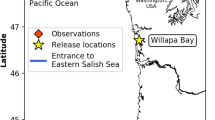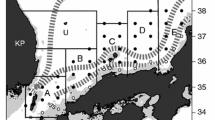Abstract
A massive bloom of the giant jellyfish Nemopilema nomurai occurred in waters offQinhuangdao, a port city in Hebei Province, in July 2013. However, jellyfish larvae were not found in this location during the previous winter and spring. To determine the possible origin of the giant jellyfish medusa in the Bohai Sea, we developed a backward particle-tracking model and a series of numerical simulations were conducted by using the hydrodynamic, three-dimensional Regional Ocean Modeling System (ROMS) results. The simulated results showed that passive particles, representing jellyfish medusae, released in surface waters at different dates during the summer had consistent trajectories. Particles released at the sea surface on August 1 and 15 could be traced back to the center of the Bohai Sea and to waters between Feiyan Shoal and the new Huanghe (Yellow) River estuary. Particles released on July 1 and 15 could also be traced back to the center of the Bohai Sea and to waters between Feiyan Shoal and only to Zhuangxi tide station. However, none of the particles released in the middle and bottom water layers could be traced back to those areas. Based on the results of the numerical simulations, the distribution characteristics of seafloor sediments, and observational data for giant jellyfish in the region, we suggest that waters between Feiyan Shoal and the new Huanghe River estuary are the likely origin of giant jellyfish observed near Qinhuangdao in summer.
Similar content being viewed by others
References
Barnier B. 1998. Forcing the ocean. In: Chassignet E P, Verron J eds. Ocean Modeling and Parameterization. Kluwer Academic, The Netherlands. p.45–80.
Brodeur R D, Mills C E, Overland J E, Walters G E, Schumacher J D. 1999. Evidence for a substantial increase in gelatinous zooplankton in the Bering Sea, with possible links to climate change. Fisheries Oceanography, 8 (4): 296–306.
Fennel K, Wilkin J, Levin J, Moisan J, O’Reilly J, Haidvogel D. 2006. Nitrogen cycling in the Middle Atlantic Bight: results from a three-dimensional model and implications for the North Atlantic nitrogen budget. Global Biogeochemical Cycles, 20 (3): GB3007, http://dx.doi. org/10.1029/2005GB002456.
Gao S, Huang J, Bai T, Cao Y J, Xu J L. 2014. Study on the ensemble forecast of oil spilled sources. Marine Sciences, 38 (3): 42–45. (in Chinese with English abstract)
Huang D J, Su J L, Zhang L R. 1998. Numerical study of the winter and summer circulation in in the Bohai sea. Acta Aerodynamica Sinica, 16 (1): 115–121. (in Chinese with English abstract)
Johnson D R, Perry H M, Burke W D. 2001. Developing jellyfish strategy hypotheses using circulation models. Hydrobiologia, 451 (1): 213–221.
Kawahara M, Uye S I, Ohtsu K, Iizumi H. 2006. Unusual population explosion of the giant jellyfish Nemopilema nomurai (Scyphozoa: Rhizostomeae) in East Asian waters. Marine Ecology Progress Series, 307: 161–173.
Luo X F, Wei H, Wang Y H. 2012. Processes influencing jellyfish particle tracking in the yellow sea and East China Sea. Oceanologia et Limnologia Sinica, 43 (3): 635–642. (in Chinese with English abstract)
Mills C E. 2001. Jellyfish blooms: are populations increasing globally in response to changing ocean conditions? Hydrobiologia, 451 (1-3): 55–68.
Moon J H, Pang I C, Yang J Y, Yoon W D. 2010. Behavior of the giant jellyfish Nemopilema nomurai in the East China Sea and East/Japan Sea during the summer of 2005: a numerical model approach using a particle-tracking experiment. Journal of Marine Systems, 80 (1-2): 101–114.
Nagai T. 2003. Recovery of fish stocks in the Seto Inland Sea. Marine Polluttion Bulletin, 47 (1-6): 126–131.
Penven P, Lutjeharms J R E, Marchesiello P, Roy C, Weeks S J. 2001. Generation of cyclonic eddies by the Agulhas Current in the lee of the Agulhas Bank. Geophysical Research Letters, 28(6):1055–1058.
Qiao S Q, Shi X F, Wang G Q, Yang G, Hu N J, Liu S F, Liu Y G, Zhu A M, Li C X. 2010. Discussion on grain-size characteristics of seafloor sediment and transport pattern in the Bohai Sea. Acta Oceanologica Sinica, 32 (4): 139–147. (in Chinese with English abstract)
Qin Y S, Zhao Y Y, Zhao S L. 1985. Geology in Bohai Sea. Science Press, Beijing, China. p.1–232. (in Chinese)
Wu L J, Cao C H, Huang J, Cao Y J, Gao S, Bai T. 2011. Numerical tracing simulation on green tides in the Yellow Sea for contingency forecast. Marine Sciences, 35 (6): 44–47.
Wu L J, Gao S, Liu G Y, Bai T. 2015. Study on the ensemble forecast of large jellyfish drift in the coastal waters of Qingdao. Marine Forecasts, 32 (2): 62–71. (in Chinese with English abstract)
Zhang H Y, Zhao L, Wei H. 2012. Origin of the giant jellyfish in Qingdao offshore in summer. Oceanologia et Limnologia Sinica, 43 (3): 662–668. (in Chinese with English abstract)
Zhang X Y. 1996. Ocean Outfall Modeling-Interfacing Near and Far Field Models with Particle Tracking Method. United States: Massachusetts Institute of Technology.
Ph. D. thesis. p.1–126.
Zhao B R, Cao D M. 1998. Dynamic analysis and numerical modeling of forming mechanisms of winter circulations in the Bohai Sea. Oceanologia et Limnologia Sinica, 29 (1): 86–96. (in Chinese with English abstract)
Zheng X R, Li Y, Rao Q H, Mu J D. 2014. Analysis of the reasons for the explosive growth of large jellyfish in the coastal waters of Qinhuangdao. Hebei Fisheries, 2): 16–20. (in Chinese with English abstract)
Zheng X R, Li Y, Zhang H P, Mu J D, Yang C C. 2014. Investigation of macro-jellyfish biomass in the Hebei coast. Hebei Fisheries, 1): 15–18, 42. (in Chinese with English abstract)
Author information
Authors and Affiliations
Corresponding author
Additional information
Supported by the National Special Research Fund for Non-Profit Marine Sector (No. 201005018) and the Open Fund of Key Laboratory of Ocean Circulation and Waves, Institute of Oceanology, Chinese Academy of Sciences (No. KLOCAW1403)
Rights and permissions
About this article
Cite this article
Wu, L., Wu, X. & Bai, T. Comprehensive analysis of the origin of giant jellyfish near Qinhuangdao in summer. Chin. J. Ocean. Limnol. 35, 1061–1069 (2017). https://doi.org/10.1007/s00343-017-6083-8
Received:
Accepted:
Published:
Issue Date:
DOI: https://doi.org/10.1007/s00343-017-6083-8




